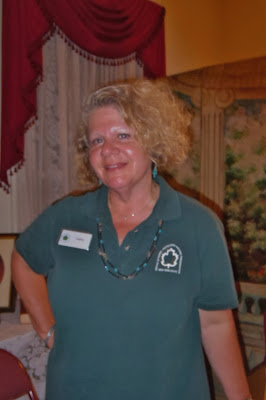Carol Rogers is a naturalist, who works for the New York State Department of Parks, Recreation, and Historic Preservation. She was the guest speaker for the evening. Her topic was on "The Great Gorge Route." This was a trolley that ran along the Niagara Gorge between the years of 1895 to 1935. Construction began in April 1895. There were all sorts of problems with the construction process, including rattlesnake attacks (that doesn't sound pleasant).
Nevertheless, the trolley's first run was in July 1895. It was described as "Niagara's Great Gorge Trip." It was one of the first electric-run trolleys in the United States. Travelers could buy their tickets for the trolley or for the steamer to Toronto at the International Theatre on Old Falls Street in Niagara Falls.
Some of the things that trolley could see included a cantilever bridge, Devil's Hole, the whirlpool rapids, and a suspension bridge. The suspension bridge was removed years ago. Back then, before the power project was built, it was quite something to see the rapids in the gorge. The water was very high, especially under the cantilever bridge, and there was a giant wave. The water level is now twenty feet lower.
The trolley ran every fifteen minutes. For $1.25, you could spend two hours and travel 20 miles to see the sights. Many of the conductors were Canadian medical students. In the summer, you could ride in open cars. In the rest of the years, the cars were closed.
Sometimes, famous people rode the trolley. They rode in the VIP car, which offered them the ride of luxury. President William McKinley rode the train on September 6th, 1901. He should have stayed in Niagara Falls. Instead, he went to Buffalo to see the Pan-American Exposition. There, just hours after his trolley ride, he was shot outside of the Temple of Music. He died a few days later. It is unclear as to whether he died from the gunshot wound or from botched surgery.
The Prince of Wales visited Niagara Falls and rode the trolley on September 10th, 1927.
As for the trolley: It did not run in March and April, when ice jams and rock slides were likely to occur. One of the biggest ice jams occurred on April 20th, 1909. Other problems included a rock slide on September 17th, 1935. The shale is still unstable and the location near the rock slide is still blocked off from hiking.
There were other trolleys, as well. One was the Lewiston and Youngstown Frontier Railway. People could visit Fort Niagara by way of the trolley. There was a single track on Center Street in Lewiston. When the train stopped running, the track was promptly removed. I have no clue as to the reason for that.
|





No comments:
Post a Comment